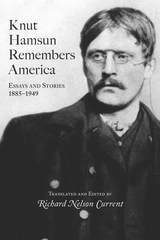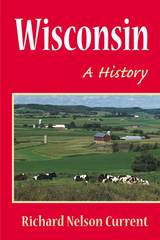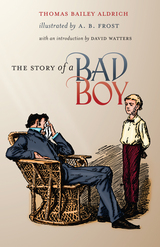3 books about Current, Richard Nelson

Knut Hamsun Remembers America
Essays and Stories, 1885-1949
Knut Hamsun, Translated and Edited by Richard Nelson Current
University of Missouri Press, 2003
When Americans remember him at all, they no doubt think of Knut Hamsun (1859–1952) as the author of Hunger or as the Norwegian who, along with Vidkun Quisling, betrayed his country by supporting the Nazis during World War II. Yet Hamsun, winner of the Nobel Prize in 1920 for his novel The Growth of the Soil, was and remains one of the most important and influential novelists of his time. Knut Hamsun Remembers America is a collection of thirteen essays and stories based largely on Hamsun’s experiences during the four years he spent in the United States when he was a young man. Most of these pieces have never been published before in an English translation, and none are readily available.
Hamsun’s feelings about America and American ways were complex. For the most part, they were more negative than positive, and they found expression in many of his writings—directly in his reminiscences and indirectly in his fiction. In On the Cultural Life of Modern America, his first major book, he portrayed the United States as a land of gross and greedy materialism, populated by illiterates who were utterly lacking in artistic originality or refinement. Although the pieces in this collection are not all anti-American, most of them emphasize the strangeness and unpleasantness, as the author saw it, of life in what he called Yankeeland.
Arranged chronologically, the pieces fall into three categories: Critical Reporting, Memory and Fantasy, and Mellow Reminiscence. The Critical Reporting section includes articles that appeared in Norwegian or Danish newspapers soon after each of Hamsun’s two visits to America and that give his views on a variety of American subjects, and includes an essay devoted to Mark Twain. Memory and Fantasy comprises narratives of life in America, most of which are presented as personal experiences but which actually are blends of fact and fiction. Mellow Reminiscence includes later and fonder recollections and impressions of the United States.
The pieces in this collection provide variations on a theme that runs through much of American history—European criticism of American ways. They give vivid, at times distorted, pictures of life as it was in the United States. They tell us something about the development of the worldview of a man who became a great writer, only to jeopardize his reputation by defending the Nazi oppressors of his own people. Knut Hamsun Remembers America will appeal to anyone interested in the history of American civilization or, more specifically, in the history of anti-Americanism.
[more]

We Cannot Escape History
Lincoln and the Last Best Hope of Earth
Edited by James M. McPherson
University of Illinois Press, 1995
A classic collection examining Lincoln's commitment to preserving a union, free of slavery
A who's who of Lincoln scholars explores why Lincoln considered the Union the "last best hope of earth" and how his words and deeds have continued to shape the nation through modern times. Focusing on Lincoln's view of American history and his legacy for the United States and the world, this volume demonstrates the complexity of the problems Lincoln faced and the genius of his leadership in preserving the nation while purging it of slavery.
A who's who of Lincoln scholars explores why Lincoln considered the Union the "last best hope of earth" and how his words and deeds have continued to shape the nation through modern times. Focusing on Lincoln's view of American history and his legacy for the United States and the world, this volume demonstrates the complexity of the problems Lincoln faced and the genius of his leadership in preserving the nation while purging it of slavery.
[more]

Wisconsin
A HISTORY
Richard Nelson Current
University of Illinois Press, 1977
A haven for summer tourists and winter sport enthusiasts, Wisconsin is famed for its physical beauty and its prodigious production of cheese and dairy products. Richard Nelson Current's compact history reveals the colorful past of America's Dairyland, from early explorers and gangsters to sports heroes and cheeseheads.
Both the Ringling Brothers' "World's Greatest Shows" and Barnum & Bailey's "Greatest Show on Earth" originated in Wisconsin, along with the typewriter, Johnson's Wax, and the first automatic assembly line (for manufacturing automobile frames). Wisconsin inventors contributed to the mechanization of American farms by developing harvesters, reapers, cultivators, threshers, and other machinery. Sen. Robert M. ("Fighting Bob") La Follette brought progressive reform to the state; a few decades later another Wisconsin native, Joseph McCarthy, revealed his agenda as a U.S. senator.
The Gideons, who place Bibles in hotel room nightstands, got their start in Wisconsin, and the state's factories produced most of the 107 steam shovels that dug the Panama Canal. Even before American Motors in Kenosha became Wisconsin's largest employer, Wisconsinites were responsible for such car-related developments as the first four-wheel-drive vehicle and an early tire-patching kit.
To football fans, the capital of Wisconsin is Green Bay, where in 1919 Earl Louis Lambeau organized the Packers. Even during the team's fifteen-year losing streak, Green Bay consisted, as one reporter observed, of "nearly 50,000 wild-eyed maniacs [who] know more about football than any other 50,000 people on the face of the earth."
Fast-paced and entertaining, Current's history chronicles how Wisconsin's homegrown ideas, from the "Wisconsin Idea" of efficient state government to ski-tows and speedometers, made their way into the broader marketplace of American culture.
Both the Ringling Brothers' "World's Greatest Shows" and Barnum & Bailey's "Greatest Show on Earth" originated in Wisconsin, along with the typewriter, Johnson's Wax, and the first automatic assembly line (for manufacturing automobile frames). Wisconsin inventors contributed to the mechanization of American farms by developing harvesters, reapers, cultivators, threshers, and other machinery. Sen. Robert M. ("Fighting Bob") La Follette brought progressive reform to the state; a few decades later another Wisconsin native, Joseph McCarthy, revealed his agenda as a U.S. senator.
The Gideons, who place Bibles in hotel room nightstands, got their start in Wisconsin, and the state's factories produced most of the 107 steam shovels that dug the Panama Canal. Even before American Motors in Kenosha became Wisconsin's largest employer, Wisconsinites were responsible for such car-related developments as the first four-wheel-drive vehicle and an early tire-patching kit.
To football fans, the capital of Wisconsin is Green Bay, where in 1919 Earl Louis Lambeau organized the Packers. Even during the team's fifteen-year losing streak, Green Bay consisted, as one reporter observed, of "nearly 50,000 wild-eyed maniacs [who] know more about football than any other 50,000 people on the face of the earth."
Fast-paced and entertaining, Current's history chronicles how Wisconsin's homegrown ideas, from the "Wisconsin Idea" of efficient state government to ski-tows and speedometers, made their way into the broader marketplace of American culture.
[more]
READERS
Browse our collection.
PUBLISHERS
See BiblioVault's publisher services.
STUDENT SERVICES
Files for college accessibility offices.
UChicago Accessibility Resources
home | accessibility | search | about | contact us
BiblioVault ® 2001 - 2024
The University of Chicago Press









